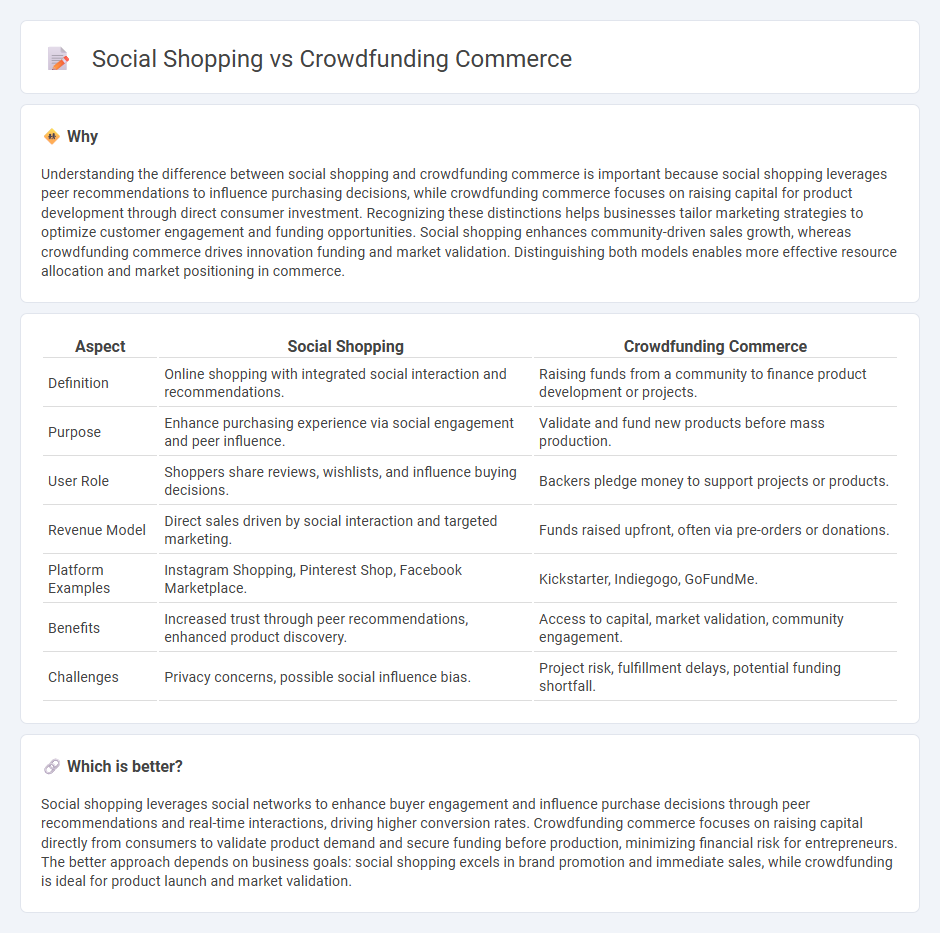
Social shopping integrates real-time interaction and peer recommendations to enhance the consumer experience, leveraging platforms like Instagram and TikTok for seamless product discovery. Crowdfunding commerce focuses on raising capital from a large group of backers via platforms such as Kickstarter and Indiegogo, validating product demand before mass production. Explore the distinct benefits and strategic applications of social shopping versus crowdfunding commerce to optimize your business model.
Why it is important
Understanding the difference between social shopping and crowdfunding commerce is important because social shopping leverages peer recommendations to influence purchasing decisions, while crowdfunding commerce focuses on raising capital for product development through direct consumer investment. Recognizing these distinctions helps businesses tailor marketing strategies to optimize customer engagement and funding opportunities. Social shopping enhances community-driven sales growth, whereas crowdfunding commerce drives innovation funding and market validation. Distinguishing both models enables more effective resource allocation and market positioning in commerce.
Comparison Table
| Aspect | Social Shopping | Crowdfunding Commerce |
|---|---|---|
| Definition | Online shopping with integrated social interaction and recommendations. | Raising funds from a community to finance product development or projects. |
| Purpose | Enhance purchasing experience via social engagement and peer influence. | Validate and fund new products before mass production. |
| User Role | Shoppers share reviews, wishlists, and influence buying decisions. | Backers pledge money to support projects or products. |
| Revenue Model | Direct sales driven by social interaction and targeted marketing. | Funds raised upfront, often via pre-orders or donations. |
| Platform Examples | Instagram Shopping, Pinterest Shop, Facebook Marketplace. | Kickstarter, Indiegogo, GoFundMe. |
| Benefits | Increased trust through peer recommendations, enhanced product discovery. | Access to capital, market validation, community engagement. |
| Challenges | Privacy concerns, possible social influence bias. | Project risk, fulfillment delays, potential funding shortfall. |
Which is better?
Social shopping leverages social networks to enhance buyer engagement and influence purchase decisions through peer recommendations and real-time interactions, driving higher conversion rates. Crowdfunding commerce focuses on raising capital directly from consumers to validate product demand and secure funding before production, minimizing financial risk for entrepreneurs. The better approach depends on business goals: social shopping excels in brand promotion and immediate sales, while crowdfunding is ideal for product launch and market validation.
Connection
Social shopping leverages user-generated content and peer recommendations to enhance product discovery and trust, while crowdfunding commerce utilizes collective financial support to launch and validate products. Both models rely on community engagement and social networks to drive sales and innovation, creating a feedback loop between consumer demand and product development. This synergy accelerates market entry for new products and fosters a collaborative commerce ecosystem.
Key Terms
Capital Raising
Crowdfunding commerce enables entrepreneurs to raise capital directly from a diverse online audience, leveraging platforms like Kickstarter and Indiegogo to secure funds through pre-sales or equity investments. Social shopping combines ecommerce with social media by facilitating purchasing decisions through peer recommendations, but it primarily boosts sales rather than capital raising. Discover how these strategies differ in driving business growth and funding opportunities.
Peer Influence
Crowdfunding commerce leverages peer influence by enabling consumers to collectively fund products, amplifying trust and social validation through group participation. Social shopping thrives on peer recommendations and shared experiences, creating personalized purchase motivations rooted in social connections. Explore how these dynamics shape modern consumer behavior and boost sales potential.
Platform Engagement
Crowdfunding commerce drives platform engagement by leveraging community investment models that encourage backers to actively participate in product development and marketing. Social shopping enhances engagement through interactive features like sharing, reviews, and real-time recommendations, fostering a collaborative buying experience. Explore deeper insights on how each model boosts user interaction and retention.
Source and External Links
Types of crowdfunding for eCommerce brands - Crowdfunding in eCommerce allows businesses to fund projects or scale growth by sourcing capital from many backers, offering benefits like strategic investment flexibility, boosting brand awareness, and overcoming the limitations of traditional loans or revenue-based financing.
10 Best Crowdfunding Sites and Platforms in 2025 - Crowdfunding enables commerce projects to access diverse funding sources, validate their business ideas with real market demand, increase product visibility, and build a community before launch, making it an effective method to raise money and market concurrently.
What is crowdfunding? Here are four types to know - Crowdfunding offers eCommerce startups advantages such as access to capital, market validation, audience building, feedback collection, lower risk compared to traditional funding, publicity benefits, and new partnership opportunities by leveraging the collective support of many individuals online.
 dowidth.com
dowidth.com